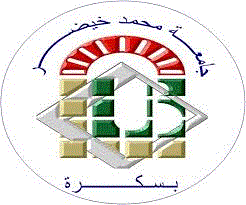| Titre : | Deep learning for multivariate data. Application to "Digital Twin" |
| Auteurs : | Abderrahim Assassi, Auteur ; Sadek Labib Terrissa, Directeur de thèse |
| Type de document : | Monographie imprimée |
| Editeur : | Biskra [Algérie] : Faculté des Sciences Exactes et des Sciences de la Nature et de la Vie, Université Mohamed Khider, 2022 |
| Format : | 1 vol. (59 p.) / couv. ill. en coul / 30 cm |
| Langues: | Anglais |
| Mots-clés: | Digital twin, multivariate data, data drift, Statistics, deep learning model |
| Résumé : |
Digital twin has become recently an important concept in industry and academia. Make a digital representation of a system or a physical assets help to improve processes, study the expected behaviour of production and maximize benefits. Many problems make the digital twin model not accurate to the real or physical asset, one of these problems is Data Drift. In this thesis we will make a system to resolve inaccurate of a model due to the data drift problem. The system detects the drift in data using statistics calculation. we calculate mean and variance for each features in each data initial and new (online), then we calculate the percentage of change between the two calculation results. We update to the digital twin basing the calculation results. |
| Sommaire : |
Dedication . I Acknowledgments ……… II Abstract …………. III List of Figures . VIII List of source code ……. IX List of Tables … X GENERAL INTRODUCTION … 01 CHAPTER 1 : DIGITAL TWIN Introduction ……….. 03 1. History …….. 03 2. Definitions ……. 04 2.1. Digital twin …. 04 2.2. Level of integration . 06 2.2.1. Digital Model ….. 06 2.2.2. Digital Shadow …………. 07 2.2.3. Digital Twin ……. 07 3. Digital Twin Applications ……….. 07 3.1. Manufacturing ………………. 07 3.2. Smart cities ……………………… 08 3.3. Healthcare ……………….. 08 3.4. Automotive …………………… 09 4. Importance of Digital Twin ………. 09 5. Types of Digital twin …………………………. 10 Digital Twin Prototype (DTP) ……………… 10 Digital Twin Instance (DTI) ……………….. 10 Digital Twin Aggregate (DTA) ………… 10 6. Digital Twin life cycle …………………. 11 7. Digital twin conceptual architecture… 12V Conclusion …………………………… 13 CHAPTER 2 : DATA DRIFT Introduction ………… 14 1.Definitions ……………….. 14 2.Causes of data drift ………………… 15 3.Drift types …………… 15 3.1. Covariate Shift (Shift in the independent variables) 15 3.2. Prior Probability Shift (Shift in the target variable) 16 3.3. Concept Shift …. 16 3.3.1. Gradual Concept Drift 17 3.3.2. Sudden Concept Drift…… 18 3.3.3. Recurring Concept Drift 18 4. Detect Data Drift …….. 19 Methods for detection of Data Drift 19 1. Population Stability Index (PSI) . 20 2. Kolmogorov-Smirnov Windowing method (KSWIN). 20 3. Page-Hinkley method (PageHinkley) . 20 4. Model-Based Approach ……. 21 5. Adaptive Windowing (ADWIN) 21 6. Drift Detection Method (DDM) .. 21 7. Early Drift Detection Method (EDDM) 22 5. Handling data drift in production … 22 5.1. Blindly update model … 22 5.2. Training with weighted data 22 5.3. Incremental learning…. 22 Conclusion…. 22 CHAPTER 3 : STATISTICAL ANALYSIS OF DATA Introduction. 24 1. Definition ……… 24 2. Types of Data ………. 24 2.1.Univariate data …. 24 VI 2.2.Bivariate data …. 25 2.3. Multivariate data 25 3. Types of Statistics Analysing 26 3.1.Descriptive Statistics .. 27 3.2.Inferential Statistics ……. 27 4. The data analysis process ……. 29 4.1.Defining the question ……………. 29 4.2.Collecting the data ………….. 29 4.3.Understanding the data …………. 30 4.4.Cleaning the data …………………. 30 4.5.Analyse the data ………………………………… 4.6.Interpreting the resul……….. 31 5. Benefits of Statistical Analysis of Data31 ConcluSION…… 31 CHAPTER 4 : DEEP LEARNING Introduction ……. 32 Neural Networks and Deep Learning . 32 1. Artificial Neural Networks …….. 32 1.1. Biological neurons …… 33 1.2. Artificial neurons …… 33 1.3. Layers …… 35 2. Deep neural network architectures …. 36 2.1. Convolutional neural networks . 36 2.2. Recurrent neural networks . 38 2.3. Long Short-Term Memory … 39 Conclusion …………. 40 CHAPTER 5 : DESING OF SYSTEM Introduction ……………………41 1. Methodolog….. 41 a. Dataset deVII o File structure ……………………………… 43 b. Pre-processing ……………………………………. 45 c. Test the system ………………….. 45 d. Digital twin model ………. 46 Conclusion…… 47 CHAPTER 6 : IMPLIMENTATION AND RESULTS Introduction…… 48 1. Implementation frameworks and tools ………. 48 1.1. Google colab ………………………… 48 1.2. JupyterLab …….. 48 1.3. Anaconda …………8 1.4. Python …………………………9 1.5. TensorFlow ………………………………………49 1.6. Keras …………. 49 1.7. NumPy …………… 1.8. Matplotlib ………………………………………50 1.9. Scikit-learn ……………………………. 50 1.10. Pandas ……………………………………. 50 2. Implementation phases ……………. 50 2.1. Dataset Description …………………. 50 2.2. Loading and pre-processing the dataset …… 50 2.2.1. Import Libraries …………… 50 2.2.2. Import Dataset… 51 2.2.3. Visualise data ……………. 51 2.2.4. Checking for missing val.. 52 2.3. Test the system ……………………………………… 52 2.3.1. Calculating Mean and variance.. 52 2.3.2. Calculating Percentage of chan……… 53 2.3.3. Updating digital twin ……………………….. 53 3. Experiments and res… 54 Conclusion … |
Disponibilité (1)
| Cote | Support | Localisation | Statut |
|---|---|---|---|
| MINF/761 | Mémoire master | bibliothèque sciences exactes | Consultable |





